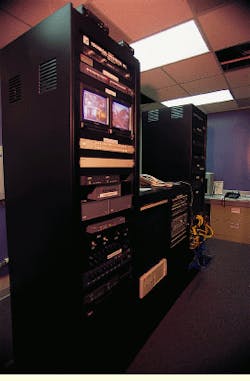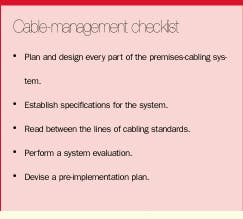The art, and science, of effective cable management
For you to be a successful cable manager, there are some simple, but essential, steps to consider.
Tim Lewis / T.A. Lewis & Associates Inc.
Once upon a time, effective cable management essentially depended on three basic elements: knowing the standards; possessing a theoretical understanding of the process and practices; and having hardware, cable, software, and human resources. It was a time when almost anyone with Ma Bell experience could and would be called upon to function as the project manager and cable-system designer.
That era is gone forever. The rapid evolution and heightened complexity of today`s telecommunications technology have transformed cable design, installation, and management into a highly specialized art and science. No longer defined by static standards, successful cabling infrastructure now requires superior solutions. Although these solutions are as unique as the circumstances, requirements, and expectations of the individual projects, there are certain key elements that always must be applied to come up with a workable solution.
Plan the design
First, do the design planning for the entire cabling infrastructure from the start. Review all equipment, connections, wires, jacks, and installation procedures that will be used. Start at the end (such as the back of the workstation) and work step-by-step, all the way back to the server or telephone system.
This procedure becomes especially important during a phased renovation project. One such example from my own experience is the five-year renovation of an eight-story courthouse. Along with the typical considerations of such a project--antiquated infrastructure and problematic building materials such as marble--this renovation is taking place in an occupied building where floors are demolished and rebuilt two at a time.
In addition to designing a wiring infrastructure that will work for the entire building when completed, the project manager must ensure that uninterrupted telecommunications services are maintained for the six floors not under construction at the time and for the temporarily relocated residents of the floors under construction. Without careful--and whole-project--planning, this project would quickly become a disaster (see "Cable-management checklist," page 64).
Buy the right equipment
After completing the design plan for the entire project, ask yourself, "What should I do now to make it easier to manage the cabling in the future?" If there is a certainty in the telecommunications industry, it is that change is inevitable and usually happens faster than expected. Whether the cabling system will survive its 15-year-and-up warranty cycle greatly depends on the preparations made at the time of installation.
Keep in mind that changes are not always caused by evolving technology. In one case I worked on, for example, a cabling infrastructure less than one year old had to be redesigned because the original design had based the location of jacks on the initial furniture-placement rendering. When the furniture placement did not work, neither did the work-area outlets.
So buy the right equipment. It may sound like obvious advice, but this step is frequently not done. The technical specifications of equipment and cabling only matter if they perform the necessary functions. Everything has to work together. A top-of-the-line hub is great, but only if provisions have been made for the required fiber to connect the hub to the server. Again, analyze the system, beginning at the user end, to make sure the equipment will provide the desired results.
Read between the standards lines
When it comes to premises-cabling standards, learn to read between the lines. Very few situations in the real world exactly match the standards and their definitions. Standards need to be applied in a practical manner.
For example, architects understandably tend to create designs that provide the maximum usable space for their clients. The fact that telecommunications closets (TCs) are supposed to be located within a certain number of feet from each other and from the work-area outlets is frequently not considered. As a result, it is always a challenge to find floor space to accommodate TCs, and not surprisingly, these spaces rarely meet the standards exactly. But experience--and reading between the lines--can teach you to what degree standards can be modified.
The difference between an adequate infrastructure and a superior cabling solution is the quality of the people who install that cabling system. Installers must possess technical skills, be detail-oriented, and have a true understanding of the expected results--these are the true installation artists who love everything about the technology, who do not accept 90% as good enough, and who consider extra effort a necessity.
Combine forces
The current practice of hiring either employees or contractors may be popular, but the most effective way to handle staffing is to combine the use of in-house personnel with the practice of outsourcing. In-house staff can handle day-to-day moves, adds, and changes, while overflow and special projects such as major expansions can be outsourced.
An international mining operation headquartered in England, for example, uses in-house cabling staff to manage day-to-day issues, while the company contracts outside sources for emergencies and to manage its wide area network, which connects multiple sites internationally. One result of this in-house/ outsourcing synergy has been the documented recovery of more than $250,000 in toll-fraud charges in the last two years.
Document the installation
If the cable manager does not know the locations of all the cabling equipment as well as where all the cabling starts and finishes, it does not matter whether the right hardware and cabling have been masterfully installed with the greatest speed and to the highest technical specifications. An undocumented cabling system cannot be managed effectively. Every work area and cable needs to be physically labeled in a standardized method.
Following labeling, develop a process to keep the cable records up-to-date. One of the worst horror stories resulting from lack of documentation that I know of occurred in a medical complex with more than 800 telephone extensions located in 24 different buildings within a five-block radius. Virtually nothing was documented on the installation and maintenance of the old analog telephone system cabling, and over the years, some of the cables for the complex had been half-tapped. When it came time to replace the analog system with an all-new digital system, the installation was a nightmare. The costs for replacement, installation, and cutover tripled because of lack of documentation.
The right cable-management software can facilitate the process of documenting original as well as changed, moved, and added technology. Look for software that can be purchased in modules that can be integrated with each other. Individual modules can include cable management, inventory control, a personnel directory, work-order/trouble tickets, and an Autocad interface. By selecting these integrated products and linking together the various modules, updating one module automatically updates the others. Look for products that are user-friendly and will import and export with other commonly used software packages such as databases.
The final element in successful cabling-plant management is establishing and following procedures. All information, resources, and equipment must be organized into systematic and logical procedures. Try to have a procedure for everything because the procedure is the glue that keeps the other elements together and provides a road map for creating superior solutions.
For developing cabling infrastructures, the process should include planning, design, specifications, evaluation, and pre- implementation planning as well as on-site project management, progress reviews, management of change, design modifications, a punch list, and final evaluation, testing, and certification.
In an era when complex technologies permeate almost every aspect of our everyday lives, cable management is more essential than ever. Knowing the elements of effective cable management is relatively easy; putting the elements into practice in the real world often is not.
On a good day, effective cable management takes knowledge, discipline, and dedication to professionalism. On a not-so-good day, it takes all of that, as well as the realization that if cable management were easy, there would be no need for superior cabling solutions.
The first step in planning a cabling infrastructure is to review every piece of voice, video, data, and audio equipment as well as every connection, wire, jack, and installation procedure that will be used.
Cable-management planning includes proper placement of cables and outlets. And remember to label them in a standardized way for easy identification.
Tim Lewis is the president and founder of T.A. Lewis & Associates Inc. (Birmingham, AL), a telecommunications consulting firm specializing in voice, video, and data.



